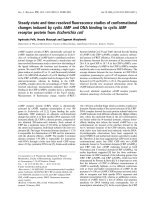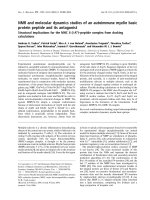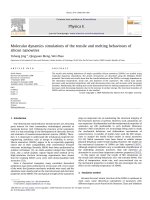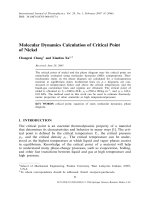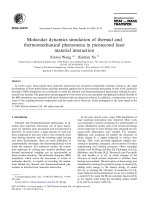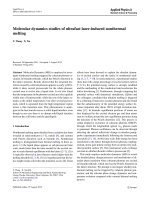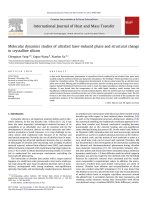molecular dynamics studies of ultrafast laser induced nonthermal melting
Bạn đang xem bản rút gọn của tài liệu. Xem và tải ngay bản đầy đủ của tài liệu tại đây (575.72 KB, 5 trang )
Appl Phys A
DOI 10.1007/s00339-012-7139-4
Molecular dynamics studies of ultrafast laser-induced nonthermal
melting
Y. Wang ·X. Xu
Received: 20 September 2011 / Accepted: 3 August 2012
© Springer-Verlag 2012
Abstract Molecular Dynamics (MD) is employed to inves-
tigate nonthermal melting triggered by coherent phonon ex-
citation in bismuth telluride, which has Peierls distortion in
the lattice structure. Results showed that the structural dis-
tortion caused by coherent phonons appears as early as 80 fs,
while it takes several picoseconds for the whole phonon-
excited area to evolve into a liquid state. It was also found
that the temperature in the phonon-excited area rises quickly
within tens of femtoseconds, while the rest of the lattice re-
mains at the initial temperature even after several picosec-
onds, which is separated from the high temperature region
across a thin transition area. This phenomenon is analo-
gous to the heat transfer across a solid–liquid interface, even
though in our case there is no abrupt solid-liquid interface
between the cold lattice and the quasiliquid.
1 Introduction
Nonthermal melting upon ultrafast laser excitation has been
revealed in semiconductors [1–3], metals [4], and systems
with Peierls distortion such as bismuth [5]. Nonthermal
melting is distinguished from thermal melting in three as-
pects: (1) the liquid phase appears at sub-picosecond time
scale, much faster than the time needed for the excited car-
rier to reach thermal equilibrium with the lattice [2–7], (2) it
is typically observed at laser fluences much higher than the
melting threshold [2, 3, 8], (3) it is hypothesized that the lat-
tice might remain cold when the transition occurs [6]. Great
Y. Wa n g · X. Xu (
)
School of Mechanical Engineering and Birck Nanotechnology
Center, Purdue University, West Lafayette, IN 47907, USA
e-mail:
Fax: +1-765-4940539
efforts have been devoted to explain the ultrafast dynam-
ics of excited carriers and the lattice in nonthermal melt-
ing [1, 2, 5, 7–10]. In semiconductors, experimental studies
show that with a large percentage of excited carriers (above
5∼6 %), the potential energy surface is strongly modified
and the antibonding of the conduction band accelerates the
lattice disordering [1]. Furthermore, through computing the
potential surface with dynamical simulations, Zijlstra and
his colleagues concluded that ultrafast melting is triggered
by a softening of transverse acoustic phonons and also found
that the anharmonicity of the potential energy surface be-
comes important after about 100 fs at high excitation den-
sities [11]. In bismuth, equilibrium positions of atoms are
first displaced by the excited electron gas and then atoms
start to oscillate around the new equilibrium positions along
the direction of the Peierls distortion [12]. This process is
called displacive excitation of coherent phonons (DECP),
through which the longitudinal optical A
1g
phonon mode
is generated. Phonon oscillations can be observed through
detecting the optical reflectivity change in ultrafast pump-
probe experiments immediately following the femtosecond
laser pulse [13, 14]. At this time scale, little energy has been
transferred to the lattice through electron-phonon coupling;
instead, atoms gain kinetic energy from an intensively mod-
ified potential surface [5]. This mechanical work exchange
can lead to ultrafast disorder within a picosecond [5].
This study employs molecular dynamics (MD) to reveal
the detailed phase change processes and mechanisms of ul-
trafast phase transition when coherent phonons are excited
in bismuth telluride, which also has the Peierls distortion in
the lattice structure. We attempt to investigate whether non-
thermal melting can be triggered by coherent phonon gen-
eration, and the relevant phase change dynamics and tem-
perature evolution compared with a normal thermal melting
process.
Y. Wang, X. Xu
2 Numerical approach
As illustrated in Fig. 1,bulkBi
2
Te
3
has a rhombohedral
primitive cell in the space group R
¯
3m. At room tempera-
ture, the corresponding conventional cell is hexagonal with
parameters a =4.369 Å and c =30.42 Å [15]. The hexag-
onal close-packed atomic structure consists of a periodic
five-fold layer along the c-axis: Te I–Bi–Te II–Bi–Te I. The
bonding force is covalent within the five-fold layers and Van
der Waals between the layers [16]. The nearest-neighbor
distances between atoms in different monatomic layers are
3.04 Å for the Te I–Bi bond, 3.24 Å for the Te II–Bi bond,
and 3.72 Å for the Te I–Te I bond [16].
Huang and Kaviany developed a set of three-body in-
teratomic potentials for bulk Bi
2
Te
3
[17]. Even though the
properties predicted by this set of 24-parameter potentials
agree well with experimental results, the computation cost
of MD using a three-body potential can be very high. Qiu
and Ruan developed a set of two-body potentials from the
density-functional theory (DFT) and implemented into MD
simulations to predict the lattice thermal conductivity of
bulk Bi
2
Te
3
[15]. Their predicted lattice thermal conductiv-
ities agree with experimental results within the temperature
range from 150 to 500 K. The fitted two-body potentials take
the form:
Fig. 1 The crystal structure of
Bi
2
Te
3
, where both
rhombohedral and conventional
hexagonal unit cells are
delineated
U
ij
=U
s
ij
+
q
i
q
j
r
ij
=D
e
1 −exp
−a(r
ij
−r
0
)
2
+
q
i
q
j
r
ij
(1)
Here, the short-range potential takes the Morse form,
where D
e
corresponds to the depth of potential well, r
0
de-
notes the equilibrium bond distance, and a is the bond elas-
ticity. Only the nearest-neighbor interactions are considered.
q
i
and q
j
in the last term are the effective charges of the ions.
The charge values are 0.38, −0.26, and −0.24 for Bi, Te I,
and Te II, respectively.
In this study, the two-body potentials are adopted. To
evaluate the long-range Coulomb interaction effectively,
Wolf’s summation [18] is applied with a cut-off radius of
11.28 Å. The parameters for the Morse potentials are listed
in Table 1.
In the MD simulation, coherent phonons are excited in
the following way: the two pairs of Bi and Te I atoms
are stretched from the center (Te II) along the c-axis, and
then the atoms are released. This is to imitate the displace-
ment from the atomic equilibrium positions due to photon-
dipole interaction when A
1g
phonons are excited by ultra-
fast laser pulses. Frequency of A
1g
phonons calculated us-
ing this method is 1.83 THz, which is only about 3 % lower
than that measured with ultrafast pump-probe experiments
(1.86 THz) [13].
3 Results and discussion
In order to compare the phase change phenomena with
and without coherent phonon excitation, simulations of two
cases are conducted on a 27 nm-thick Bi
2
Te
3
thin film. The
lateral dimension is about 1.3 × 1.3 nm, with the period
boundary condition applied. We assume the laser pulse is
a delta function. In the first case, the energy from the laser
pulse is treated as a heating source. All the laser energy is
absorbed by electrons at time t =0, and then the energy de-
posited into electrons is transferred to the lattice exponen-
tially. At time t, the laser energy absorbed between z and
z +z can be expressed as
Table 1 Parameters of the
Morse potential
Bond D
e
(eV) a (1/Å) r
0
(Å) r
c
(Å)
Bi–Bi 0.085 2.212 4.203 5.5
Bi–Te I 0.975 1.285 3.089 4.0
Bi–Te II 0.582 1.257 3.251 4.0
Te I–Te I 0.076 1.675 3.642 5.0
Te I–Te II 0.807 0.731 4.497 5.5
Te II–Te II 0.066 2.876 4.312 5.0
Molecular dynamics studies of ultrafast laser-induced nonthermal melting
Fig. 2 Snapshots of atomic distributions of (a) laser heating with absorbed laser fluence of 13.1 J/m
2
and (b) nonthermal melting triggered by
coherent phonon excitation, corresponding to absorbed fluence 13.1 J/m
2
E =AF
t
τ
exp(−t/τ)
exp(−z/δ) −exp
−(z +z)/δ
(2)
where A is the illuminated area, F is the absorbed laser flu-
ence, and t is the time step in MD. τ is the time con-
stant of energy transfer (5 ps used in the calculation) and
δ is the absorption depth (10 nm at the laser wavelength of
400 nm). In the calculation, the absorbed laser energy is de-
posited into the lattice through scaling the velocity with a
factor S =
√
1 +E/E
k
, where E
k
is the kinetic energy of
atoms within the layer from z to z +z. The absorbed laser
fluence used in the calculation is 13.1 J/m
2
.
In the second case, coherent A
1
1g
phonons are excited
within the top 10 nm layer, and are randomly distributed.
The amount of energy deposited into coherent phonons is
the same as that in the first case.
Figure 2 illustrates the snapshots and temperature distri-
butions of both cases. In the case of normal thermal heating,
thermal distortion appears around 5 ps (Fig. 2a). A continu-
ous temperature gradient is established across the whole film
throughout the time of consideration. The surface tempera-
ture at 5 ps is around 2,000 K, much higher than the melt-
ing temperature (858 K [19]), and the structure remains as
solid. This phenomenon is called super heating, which has
been observed in a wide variety of solids during ultrafast
heating [20, 21]. The liquid phase starts to nucleate at the
surface around 5 ps, then the liquid-solid interface moves
into the sample, which is typical for thermal melting. For
the second case with coherent phonon generation, structure
distortion starts as early as 80 fs (Fig. 2b)), scattered at iso-
lated locations. Around 500 fs, the distortion develops into
larger areas and localized liquid-like structure starts to ap-
pear. Here, both the distortions caused by coherent phonons
and from the raised temperature contribute to the formation
of the localized liquid-like structure, since part of the en-
ergy deposited into the coherent phonons is converted to the
kinetic energy of atoms. However, we call this phenomena
“nonthermal” melting in order to distinguish it from the pure
heating situation. An interesting phenomenon was observed
here: the liquid phase was first developed within each five-
fold layer, and then the distortion crosses layers, and sweeps
the whole phonon-excited area. This feature might be unique
to Bi
2
Te
3
, where there are different bonding forces within
(covalent) and between (Van der Waals) unit cells. A com-
plete transition to liquid takes several picoseconds. We call
the mixed phase before transition to liquid a “quasi-liquid”
phase.
Another observation is that the lattice underneath the
phonon-excited area is almost undisturbed during nonther-
mal melting. This indicates that the heat conduction from
phonon-excited area to the cold lattice is greatly suppressed.
From the temperature profile, Fig. 3b, the temperature steps
from around 2,000 K to 300 K across a region of about 5 nm
thick. The temperature below this 5 nm-thick region remains
around 300 K even at around 5 ps, which is very different
from the pure heating case. The highest surface temperatures
in the two cases are almost identical. Similar phenomenon
is observed in the ultrafast laser melting of silver [22]. It
Y. Wang, X. Xu
Fig. 3 Temperature distribution in Bi
2
Te
3
thin film. (a) Laser heating with absorbed laser fluence of 13 J/m
2
and (b) nonthermal melting triggered
by coherent phonon excitation, corresponding to absorbed fluence 13 J/m
2
Fig. 4 Radial distribution functions of the Bi–Te bond at different time
after laser irradiation
was found from the experiment that only a thin surface layer
undergoes melting during the first several picoseconds. The
melting front propagates into the sample with a very low ve-
locity and the surface temperature remains above the melt-
ing temperature for 20∼30 ps. The reason for limited heat
conduction from the melted surface area is attributed to the
weak electron-phonon coupling [22]. On the other hand, this
cold-lattice picture was not consistent with the ab-initio MD
study of silicon [23]. In this study, no electronic effect is
considered. Therefore, the weak electron-phonon coupling
could not explain the ineffective heat transfer between the
phonon-excited area and the cold lattice. In our results, the
difference in the temperatures between the area where laser
energy is deposited and the lattice below is caused by the
effective transfer of energy from photons to the coherent
phonons.
Radial distribution function (RDF) [24] can help to un-
derstand different stages in non-thermal melting, which is
defined as
g(r
αβ
) =
V
N
n
r
αβ
→r
αβ
+dr
αβ
4πr
2
αβ
dr
αβ
(3)
where V represents the volume of the computation domain,
N is the total number of atoms, and α and β denote two dif-
ferent types of atoms. n
r
αβ
→r
αβ
+dr
αβ
is the number of pairs
of αβ atoms within the spherical shell between radius r
αβ
and r
αβ
+dr
αβ
. For laser heating with coherent phonon gen-
eration, RDFs of Bi–Te bonds are calculated at a number of
time steps and plotted in Fig. 4. Before laser heating (time
0), spikes in the RDF denote short-range and long-range or-
ders in crystalline Bi
2
Te
3
. The first two peaks in the RDFs
represent the distance between the Bi atoms and their near-
est Te I neighbors (3.07 Å) and next-nearest Te I neighbors
(5.3 Å) within the fivefold layer. At around 80 fs, the lat-
tice structures are only disturbed slightly. At around 500 fs,
peaks are blurred and shifted at small r (short-range struc-
tures) and decay at larger r, indicating that the long-range
orders start to be destroyed. From 500 fs to 5 ps, long-range
structures gradually disappear together with some short-
range structures. Only the first few peaks are still shown in
RDFs around 5 ps, which is typical for pure liquid phases.
From the analyses above, it can be seen that the phenom-
ena occurring during ultrafast laser excitation of coherent
phonons are drastically different from a normal melting pro-
cess. There can be a short time period where nonthermal
melting can occur, before the entire laser heated area be-
comes liquid.
Molecular dynamics studies of ultrafast laser-induced nonthermal melting
4 Conclusion
In summary, ultrafast nonthermal melting triggered by co-
herent phonon excitation is simulated using MD and com-
pared with normal thermal melting. The calculation results
reveal the details of how nonthermal phase transitions oc-
cur after coherent phonon excitation. It is found that long-
range orders begin to be destroyed within 500 fs after the
laser pulse, and these distortions are scattered throughout the
photo-excited layer. For Bi
2
Te
3
, this scattered distortions
then first spread within the unit cell, then cross the bound-
aries between unit cells. The transition from this “quasi-
liquid” state to liquid takes several picoseconds. The melted
layer reaches a temperature above the equilibrium melting
temperature, while the lattice underneath it remains cold.
Acknowledgements Support to this work by the Air Force Office of
Scientific Research (AFOSR) (FA9550-08-1-0091) and the National
Science Foundation (0933559) are gratefully acknowledged.
References
1. A. Rousse, C. Rischel, S. Fourmaux, I. Uschmann, S. Sebban,
G. Grillon, Ph. Balcou, E. Förster, J.P. Geindre, P. Audebert, J.C.
Gauthier, D. Hulin, Nature 410, 65 (2001)
2. C.W. Siders, A. Cavalleri, K. Sokolowski-Tinten, Cs. Toth,
T. Guo, M. Kammler, M. Horn von Hoegen, K.R. Wilson,
D. von der Linde, C.P.J. Barty, Science 286, 1340 (1999)
3. C.V. Shank, R. Yen, C. Hirlimann, Phys. Rev. Lett. 51, 900 (1983)
4. C. Guo, G. Rodriguez, A. Lobad, A.J. Taylor, Phys. Rev. Lett. 84,
4493 (2000)
5. G. Sciaini, M. Harb, S.G. Kruglik, T. Payer, C.T. Hebeisen, F.J.M.
Heringdorf, M. Yamaguchi, M.H. Hoegen, R. Ernstorfer, R.J.D.
Miller, Nature 458, 56 (2009)
6. S.K. Sundaram, E. Mazur, Nat. Mater. 767, 217 (2002)
7. P.B. Hillyard, K.J. Gaffney, A.M. Lindenberg, S. Engemann, R.A.
Akre, J. Arthur, C. Blome, P.H. Bucksbaum, A.L. Cavalieri, A.
Deb, R.W. Falcone, D.M. Fritz, P.H. Fuoss, J. Hajdu, P. Krejcik, J.
Larsson, S.H. Lee, D.A. Meyer, A.J. Nelson, R. Pahl, D.A. Reis,
J. Rudati, D.P. Siddons, K. Sokolowski-Tinten, D. von der Linde,
J.B. Hastings, Phys. Rev. Lett. 98, 125501 (2007)
8. A.M. Lindenberg, J. Larsson, K. Sokolowski-Tinten, K.J. Gaffney,
C. Blome, O. Synnergren, J. Sheppard, C. Caleman, A.G.
MacPhee, D. Weinstein, D.P. Lowney, T.K. Allison, T. Matthews,
R.W.Falcone,A.L.Cavalieri,D.M.Fritz,S.H.Lee,P.H.Bucks-
baum, D.A. Reis, J. Rudati, P.H. Fuoss, C.C. Kao, D.P. Sid-
dons, R. Pahl, J. Als-Nielsen, S. Duesterer, R. Ischebeck, H.
Schlarb, H. Schulte-Schrepping, T. Tschentscher, J. Schneider,
D. von der Linde, O. Hignette, F. Sette, H.N. Chapman, R.W.
Lee, T.N. Hansen, S. Techert, J.S. Wark, M. Bergh, G. Huldt,
D. van der Spoel, N. Timneanu, J. Hajdu, R.A. Akre, E. Bong, P.
Krejcik, J. Arthur, S. Brennan, K. Luening, J.B. Hastings, Science
308, 392 (2005)
9. D.M. Fritz, D.A. Reis, B. Adams, R.A. Akre, J. Arthur, C. Blome,
P.H. Bucksbaum, A.L. Cavalieri, S. Engemann, S. Fahy, R.W.
Falcone, P.H. Fuoss, K.J. Gaffney, M.J. George, J. Hajdu, M.P.
Hertlein, P.B. Hillyard, M. Horn-von Hoegen, M. Kammler, J.
Kaspar, R. Kienberger, P. Krejcik, S.H. Lee, A.M. Lindenberg,
B. McFarland, D. Meyer, T. Montagne, E.D. Murray, A.J. Nel-
son, M. Nicoul, R. Pahl, J. Rudati, H. Schlarb, D.P. Siddons,
K. Sokolowski-Tinten, Th. Tschentscher, D. von der Linde, J.B.
Hastings, Science 315, 633 (2007)
10. K. Sokolowski-Tinten, C. Blome, J. Blums, A. Cavalleri, C. Di-
etrich, A. Tarasevitch, I. Uschmann, E. Forster, M. Kammler, M.
Horn-von-Hoegen, D. von der Linde, Nature 422, 287 (2003)
11. E.S. Zijlstra, J. Walkenhorst, M.E. Garcia, Phys. Rev. Lett. 101,
135701 (2008)
12. T.K. Cheng, S.D. Brorson, A.S. Kazeroonian, J.S. Moodera, G.
Dresselhaus, M.S. Dresselhaus, E.P. Ippen, Appl. Phys. Lett. 57,
1004 (1990)
13. Y. Wang, X. Xu, R. Venkatasubramanian, Appl. Phys. Lett. 93,
113114 (2008)
14. C.M. Liebig, Y. Wang, X. Xu, Opt. Express 18, 20498 (2010)
15. B. Qiu, X. Ruan, Phys. Rev. B 80, 165203 (2009)
16. W. Richter, H. Kohler, C.R. Becker, Phys. Status Solidi B 84, 619
(1977)
17. B.L. Huang, M. Kaviany, Phys. Rev. B 77, 125209 (2008)
18. D. Wolf, P. Keblinski, S.R. Phillpot, J. Eggebrecht, J. Chem. Phys.
110, 8254 (1999)
19. A.F. Gibson, R.E. Burgess (eds.), Progress in Semiconductors
(Wiley, New York, 1963)
20. X. Xu, C.P. Grigoropoulos, R.E. Russo, J. Heat Transf. 117, 708
(1995)
21. X. Xu, G. Chen, K.H. Song, Int. J. Heat Mass Transf. 42, 1371
(1999)
22. W.L. Chan, R.S. Averback, D.G. Cahill, A. Lagoutchev, Phys.
Rev. B 78, 214107 (2008)
23. P.L. Silvestrelli, A. Aavi, M. Parrinello, D. Frenkel, Phys. Rev.
Lett. 77, 3149 (1996)
24. M.P. Allen, D.J. Tildesley,
Computer Simulation of Liquids
(Clarendon/Oxford University Press, Oxford/New York, 1987)
